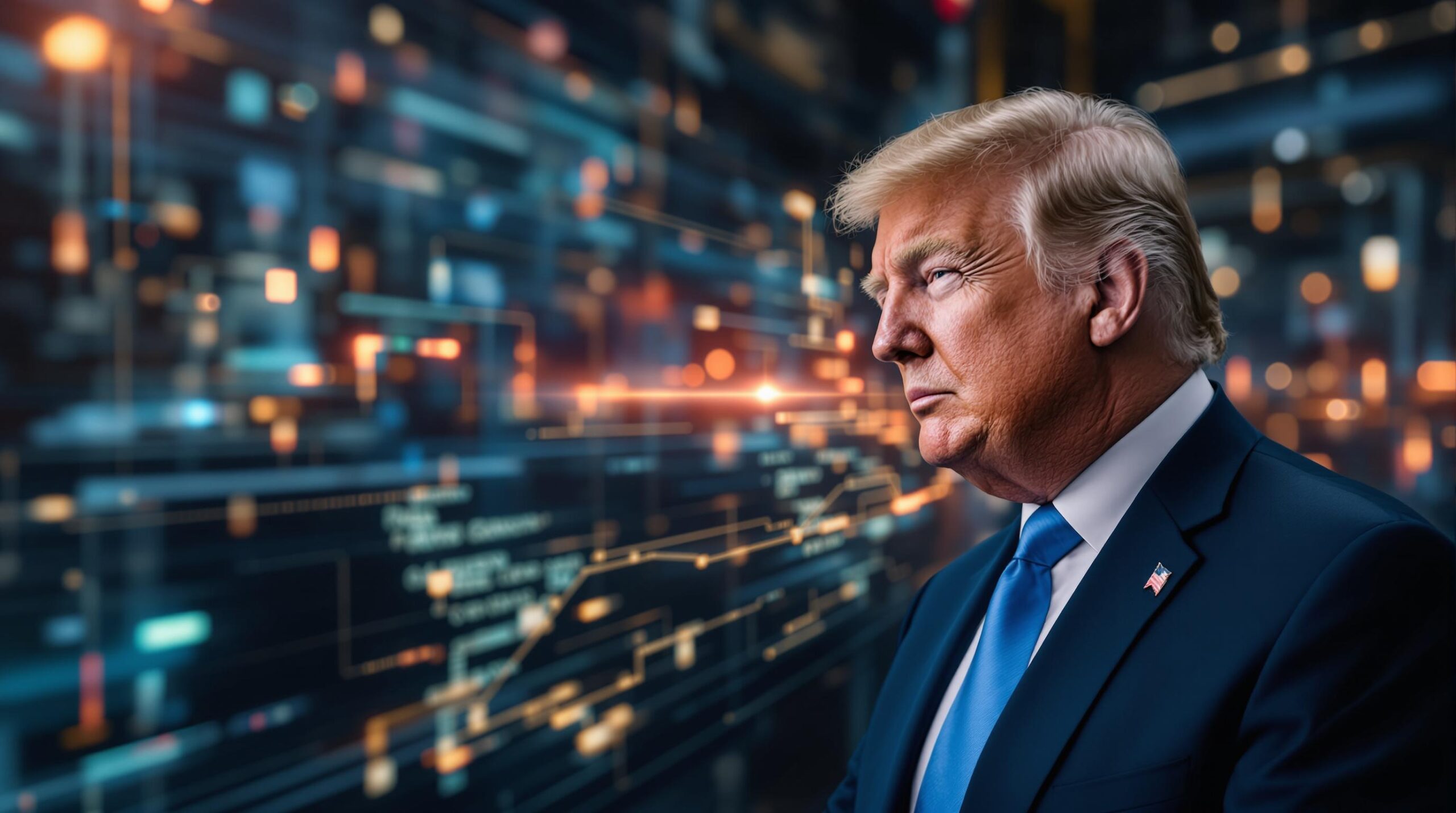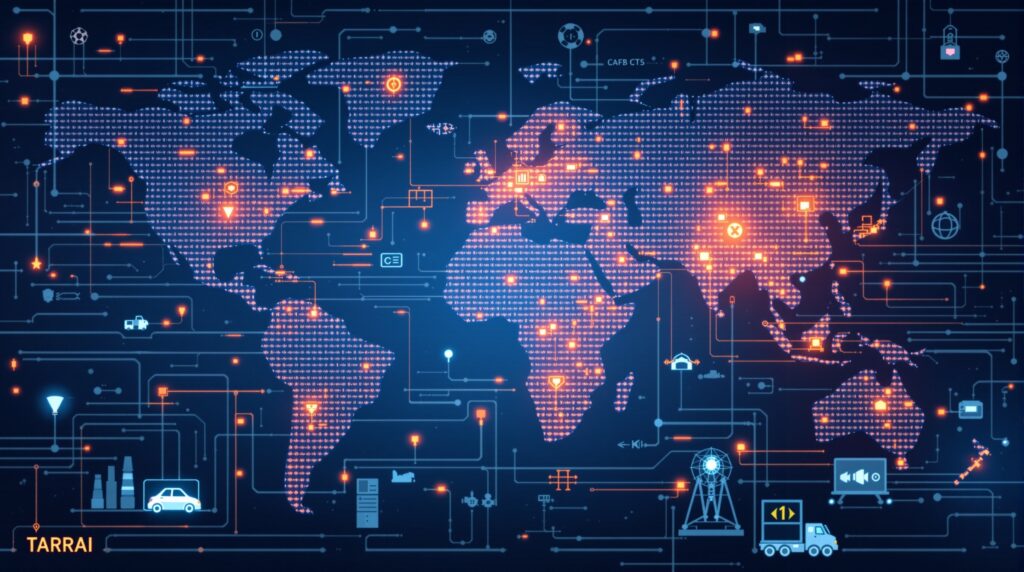The recent implementation of Trump tariffs is causing major disruptions across global supply chains, with particularly severe consequences for the AI industry that relies heavily on international component sourcing. These trade policy changes are creating a complex web of challenges for technology companies as they navigate higher costs, delayed projects, and the need to restructure their operations while maintaining competitiveness.
Key takeaways:
- A 10% baseline tariff on most imports with up to 34% additional charges for countries with large trade deficits is reshaping AI supply chains
- The US-China trade war has caused critical component shortages and 6-12 month delays for AI infrastructure projects
- Tech companies are increasingly using AI-powered logistics to navigate tariff complexities and identify alternative suppliers
- Data centers face rising construction costs of 2.4% for steel and 9.2% for electrical systems due to tariff impacts
- Two competing geopolitical AI ecosystems are emerging as supply chains fragment between East and West
Trump’s Tariff Policy: Immediate Impacts on the AI Industry
The global AI supply chain is experiencing unprecedented disruption following President Trump’s sweeping tariff policy implemented in April 2025. The policy established a 10% baseline tariff on virtually all U.S. imports, with additional tariffs up to 34% for countries with large trade deficits—China being particularly affected. These measures include 25% tariffs on steel and aluminum imports, which according to Yale Budget Lab data, have resulted in a 9.2% average cost increase for electrical equipment and 5.8% for metal products.
While semiconductors and lumber received temporary exemptions, future tariffs remain possible. The effects are already visible in the industry, with CoreWeave’s IPO filing directly linking tariffs to delayed AI project timelines. Smaller firms face steeper challenges compared to tech giants due to limited financial reserves for stockpiling critical components ahead of tariff implementation.

AI Hardware Supply Chain: The Brewing Perfect Storm
The AI industry is particularly vulnerable to these tariffs due to its reliance on imported components. GPU shortages are worsening with 10-34% tariff-driven price increases for critical AI training hardware from companies like Nvidia and its manufacturing partners. Data center construction costs are rising by 2.4% for steel and 9.2% for electrical systems, pushing AI infrastructure expansions into 6-12 month delays.
These challenges are compounded by green energy bottlenecks as tariffs hit solar panels and batteries essential for powering energy-intensive AI operations. The U.S. currently imports over 60% of data center equipment, including cooling systems and transformers, making the industry particularly susceptible to trade disruptions. Major players like Oracle and SoftBank are reportedly reconsidering $200 billion in planned AI data center investments as a result.
In anticipation of these challenges, copper wire imports surged 18% year-over-year in late 2024 amid stockpiling efforts. However, storage limitations and capital constraints make this strategy inaccessible to many smaller players in the AI ecosystem.
Did AI Design Trump’s Tariffs? The Controversial Formula
Adding to the complexity surrounding these tariffs is the controversy over whether AI itself influenced their design. Trump’s tariff formula (trade deficit ÷ total imports) appears to match outputs from leading AI models when prompted to devise trade balancing strategies. A striking 72% of economists surveyed by Politico called the tariffs “economically unsound,” with many drawing historical parallels to the 1930 Smoot-Hawley Tariff Act that many historians believe worsened the Great Depression.
While the White House denied using AI to develop the policy, experiments showed that chatbots could replicate the formula when given similar prompts. For instance, ChatGPT proposed a 10% baseline tariff when prompted to “balance trade deficits”—mirroring the actual policy. Critics highlight the formula’s oversimplification that exempts countries like Iran (which has virtually no trade with the US) while penalizing Taiwan (a critical semiconductor hub in the global AI arms race).
Corporate Adaptation: How Tech Giants Are Responding
Faced with these challenges, tech companies are rapidly adapting their supply chain strategies. According to Ivalua data, 63% of manufacturers are now exploring nearshoring options to Mexico or Canada to mitigate tariff impacts. Companies like Siemens are deploying digital twins to simulate tariff impacts on their supply chains, reducing decision times by 30% through AI-powered scenario planning.
The tariffs are also accelerating automation, with Ranpak data showing a 22% increase in warehouse robotics adoption to offset rising labor costs. Software solutions are becoming critical, with Kinaxis’ scenario-planning tools helping firms identify alternative suppliers in regions less affected by tariffs.
These adaptations are yielding results: one Midwest data center firm reportedly cut component costs by 15% using AI to reroute shipments via Chile, avoiding Chinese tariffs altogether. However, the effectiveness of these strategies varies significantly based on company size and resources.
Geopolitical Chess: Global Responses and Retaliation
The tariffs have triggered a complex geopolitical response. The U.S. Trade Representative has labeled EU digital services taxes as “trade barriers,” while Trump has linked potential tariff reductions to ByteDance’s divestment of TikTok, valued at approximately $500 billion. In response, China has implemented retaliatory tariffs of 25% on U.S. agricultural exports.
Other countries are reconsidering their policies, with the UK and Canada reviewing digital service taxes to avoid U.S. tariffs. Meanwhile, China is restricting rare earth mineral exports used in AI chips, creating additional pressure points in the semiconductor supply chain. Industry analysts predict this could result in an 18-month delay for Nvidia’s next-generation GPU launch due to supply chain disruptions across the cloud and semiconductor partnership ecosystem.
The Coming AI Innovation Slowdown
As these tariffs reshape global supply chains, a broader AI innovation slowdown appears likely. Training large language models could cost 12-18% more by 2026, with startups reliant on cloud compute credits particularly vulnerable to these price increases. The industry is seeing the emergence of competing U.S.- and China-centric AI ecosystems, similar to the split that occurred in 5G network technology.
The World Trade Organization estimates a 3.4% decline in global AI investment through 2027 due to these trade tensions. OpenAI’s partnership with UAE-based G42 has come under increased scrutiny, highlighting the growing tension between innovation goals and protectionist policies. This bifurcation of the global AI ecosystem threatens to slow overall progress as resources are divided and collaboration becomes more challenging.
The Data Center Crisis: Power, Costs, and Construction Delays
AI facilities already consume 4-6% of U.S. electricity, and the tariffs threaten energy sustainability plans for these power-hungry operations. While hyperscalers like AWS and Google Cloud can absorb some costs by renegotiating supplier contracts, construction delays of 6-12 months are becoming standard for new AI infrastructure projects.
The limitations on stockpiling components are particularly affecting smaller players who lack the financial resources of tech giants. U.S. fabrication facility construction is lagging 10-15 years behind capacity needs, creating a fundamental bottleneck for domestic semiconductor production that tariffs alone cannot solve.
Future of AI Supply Chains: Fragmentation or Resilience?
Reshoring semiconductor production remains challenging despite tariff incentives, as the cost-effectiveness of Asian manufacturing persists with labor costs 40% higher in North America. The result is an accelerating supply chain fragmentation between East and West, with two distinct AI ecosystems developing.
AI-driven logistics solutions are becoming essential for navigating tariff complexities, but they cannot fully mitigate the long-term risks of isolating U.S. AI research from global talent and resources. The continuing regulatory uncertainty is driving cautious investment strategies industry-wide, with many companies taking a wait-and-see approach before committing to major infrastructure projects.
As the global AI supply chain adjusts to this new reality, the industry faces a period of significant transformation. The coming years will determine whether these disruptions ultimately lead to greater resilience through diversification or a permanent fracturing of the global AI ecosystem.
Sources
axios.com/pro/all-deals/2025/04/03/trump-tariffs-ai-threat
techrepublic.com/article/news-trump-tariffs-generative-ai
datacenterdynamics.com/en/analysis/donald-trump-tariffs-data-centers-liberation-day
metait.ai/us-tariffs-ai-outsourcing-strategies
futurism.com/trump-tariffs-signs-ai




